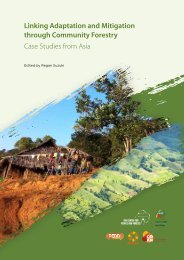Desktop Study on - Regional Climate Change Adaptation ...
Desktop Study on - Regional Climate Change Adaptation ...
Desktop Study on - Regional Climate Change Adaptation ...
Create successful ePaper yourself
Turn your PDF publications into a flip-book with our unique Google optimized e-Paper software.
Assessment of Capacity Gaps and Needs of South East Asia Countries<br />
in Addressing Impacts, Vulnerability and Adaptati<strong>on</strong> to <strong>Climate</strong> Variability and <strong>Climate</strong> <strong>Change</strong><br />
Figure 37: Percentage of people affected<br />
due to top 5 natural disasters<br />
1980-2009<br />
Flood 61%<br />
Figure 38: Percentage of people affected<br />
due to total natural disasters<br />
1980-2009<br />
Storm 0%<br />
Flood 58%<br />
Epidemic 2%<br />
Drought 39%<br />
Figure 39: Percentage of damage (US$)<br />
due to total natural disasters<br />
1980-2009<br />
Flood 98%<br />
Epidemic 0%<br />
Storm 0%<br />
Drought 4%<br />
variability <strong>on</strong> water resources in Cambodia (Hoanh<br />
et al., 2003, Snidv<strong>on</strong>gs et al., 2003, Ruosteenoha et<br />
al., 2003, Eastham et al., 2008 cited in Roth, 2009).<br />
Meanwhile, increased drought-related events<br />
including wet seas<strong>on</strong> drought spells are seen to be<br />
highly expected (Roth, 2009). Although a change<br />
in frequency of wet seas<strong>on</strong> drought is uncertain,<br />
drought in dry seas<strong>on</strong> is anticipated.<br />
Eastham et al. (2008) indicates potential impacts of<br />
climate change at the year 2030 <strong>on</strong> five areas within<br />
catchments of the Mek<strong>on</strong>g Basin in Cambodia: Se San<br />
(north-east), Kratie (central), Tônlé Sap (central),<br />
Phnom Penh (south-eastern) and Border (southern)<br />
(Roth, 2009). According to the study, increase in<br />
flooding is projected in 2030 in all the regi<strong>on</strong>s, though<br />
the level of increase varies. In the Kratie regi<strong>on</strong>, for<br />
example, frequency of extreme floods will increase<br />
from 5% to 76% annual probability, and peak flows,<br />
flood durati<strong>on</strong> and flooded area are also predicted to<br />
increase. The area of the Tônlé Sap Lake will be more<br />
minimised. In Phnom Penh and Border, the flooded<br />
area is expected to increase.<br />
The study of TKK and SEA START RC (2009) inspects<br />
that the impacts of changing climate in Cambodia are<br />
most likely to emerge through changes in the flows<br />
of the Mek<strong>on</strong>g River, altering the regi<strong>on</strong>’s unique but<br />
important flood pulse system and the resulting high<br />
aquatic productivity of the lake-floodplain system.<br />
Most of the simulated climate scenarios show similar<br />
results c<strong>on</strong>cerning hydrological impacts: the future<br />
flood pulse in the Tônlé Sap and the Cambodian<br />
floodplains is projected to be wetter with higher<br />
water levels, extended flooded area and l<strong>on</strong>ger flood<br />
durati<strong>on</strong>. Also, the average water level during the<br />
dry seas<strong>on</strong> is expected to increase (TKK and SEA<br />
START RC, 2009).<br />
In additi<strong>on</strong> to flooding, drought is also expected to<br />
occur. A case study of Kyoto University points out<br />
that the local communities in Svay Rieng province<br />
have the capacity to investigate the l<strong>on</strong>g-term<br />
changes in the drought-related c<strong>on</strong>diti<strong>on</strong>s in their<br />
area and their causes such as the decline in rainfall,<br />
steep increase in ambient temperatures and decline<br />
in biodiversity (MRC, 2009d).<br />
The abovementi<strong>on</strong>ed increase in flood and drought<br />
events will further have implicati<strong>on</strong>s for the<br />
groundwater resources. Larger wet seas<strong>on</strong> waterflows<br />
and floods and possibly higher dry seas<strong>on</strong><br />
water-flows may lead to greater recharge to aquifers<br />
and higher aquifer water levels, thus resulting in<br />
potentially greater water resource for use (Eastham<br />
109

















